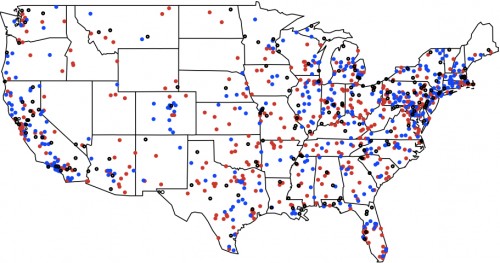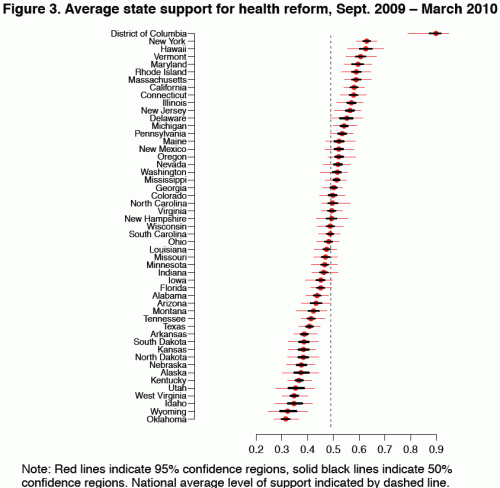The AcademyHealth Annual Research meeting in Seattle was great. I want to highlight some of the interesting research posters I saw at the conference, focusing on the work of graduate students and trainees. Richard Gonzales is a doctoral student in the interdisciplinary health policy Ph.D. program at Harvard who had an interesting poster applying small area analysis techniques to extrapolate an opinion survey’s national estimate of support for health reform to state-specific estimates of support.
When polling firms conduct surveys to determine public opinion on such topics, they typically obtain a sample that is designed to estimate the views of the nation as a whole. Also of interest are the views of residents of individual states, but conducting state-by-state surveys would be very expensive. A national perspective on a question like support of the ACA is useful, but state estimates could also be useful. The Presidential election, for example, is not determined by a national vote total, but in state-specific elections in which the winner typically gets all the electoral votes from a state. Can national data be used to estimate state-level results?
A challenge is the fact that the sample size in many states is very small (in half the states there were fewer than 10 respondents to the Dec. 2010 Gallup poll shown in the map above).The blue dots show the location of a respondent who was supportive of the ACA, the red ones, someone who was unfavorable, with black dots representing being unsure (total respondents N=1,025). Richard used a regression approach to extrapolate this information to provide a state-level support for health reform. His method is heavy on the statistics (it is a dissertation!), but he describes it this way:
To get around the challenge presented by small sample sizes, the model presented here combines the benefits of incorporating auxiliary demographic information about the states with the hierarchical modeling approach commonly used in small area estimation. The model is designed to “shrink” estimates toward the average level of support in the region when there are few observations available, while simultaneously adjusting for the demographics and political ideology in the state. This approach therefore takes fuller advantage of all information available in the data to estimate state-level public opinion.
He produced average state level estimates of support for the ACA from national estimates using the Gallup poll from Sept. 2009 to March 2010.
These estimates seem plausible to me; support is highest in Washington, DC, New York, Hawaii and Vermont and lowest in Oklahoma, Wyoming, Idaho, West Virginia and Utah. If you want more information about Richard’s work, you can email him at gonzales@fas.harvard.edu.



